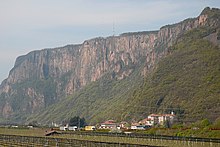Etschtal volcanic group
The Etschtaler Vulkanit-Gruppe , formerly also called Bozener Quarzporphyry , is a volcanic-sedimentary lithostratigraphic group in the southern Alps in the Bozen area . The rocks formed in the Lower Permian after dating on zircons around 285 to 275 million years ago have a thickness of up to 4000 meters and an area of over 2000 square kilometers. The volcanic group is discordant on the south alpine crystalline, locally also on the Waidbruck conglomerate or its equivalents. It is largely overlaid by sandstone from the Val Gardena formation . In the north, the volcanic rocks in the Eisack Valley extend to Waidbruck and Gröden as well as Merano, and to the south they extend with the Lagorai chain to the area northeast of Trento .
Tectonic situation
The volcanic activity was connected with a simultaneous expansion and lowering of the earth's crust in this area and thus connected with the formation of a rift system . Around 40 million years later, volcanic activity started again in the Middle Triassic , which was also linked to strong fracture tectonics. There was strong volcanic activity in the Ladinium in the area of the Dolomites and the intrusions of Predazzo and Monzoni arose. According to some researchers, the cause of the repeated stretching of the crust could be a stationary, episodically active thermal anomaly.
The structure of the Vulkanit group
Overall, there is a transition from more basic volcanics in the horizontal to more acidic volcanics in the hanging wall of the group, which is also noticeable in the color of the rocks. The andesitic to rhyodacitic Trostburg formation, named after the Trostburg near Waidbruck, consists of greenish and black rocks. The Auer formation in the hanging wall, which consists of ignimbrites, consists of rhyolithic reddish-gray to orange rocks.
The main mass of the volcanic group is made up of ignimbrites , such as the mighty Auer Formation or the equally mighty Gargazon Formation or the Torggl Formation and the Lieg Formation , as well as lavas (including the Lye Formation , the Zoll Formation and the Hafling formation ) and tuffs make up a significant proportion. In times of calm, clastic sediments such as the Vigil Formation , the Verano Formation , the Guntschna Formation and the Tregiovo Formation , in which carbon fibers and plant remains can also be found, were able to form.
use
The ignimbrites of the Bolzano volcanic group are used in many ways as building and decorative material, for example for tiles, slabs or curb stones. One reason for this, in addition to their mostly attractive color, is their easy cleavage.
Individual evidence
- ^ Möbus, Günter (1997): Geology of the Alps. An introduction to the regional geological units between Geneva and Vienna. Publishing house Sven von Loga, Cologne. ISBN 3-873612496 , p. 239.
- ↑ Environmental compatibility study for the expansion of the Vormeswald porphyry quarry, page 3. PDF file
swell
- Autonomous Province of Bolzano - South Tyrol: Appiano, geological map sheet 026, scale 1: 25,000
- GM Bargossi et al. a .: The Lower Permian Athesian Volcanic Group (AVG) in the Adige valley between Merano and Bolzano: a stratigraphic, petrographic and geochronological outline PDF file
- Rainer Brandner u. a .: Sediment 2007, excursion guide PDF file
- Hans Pichler: Contributions to the tectonics of the southern part of the Bozen porphyry plate in the area around Trento (Northern Italy) PDF file




